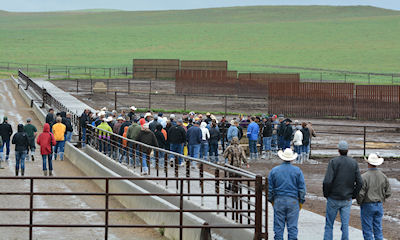June 23, 2015

It was a muddy mess on the recent North Dakota Feedlot Tour. More than an inch of rain fell the night before and during the tour of three new beef feedlots in southwest North Dakota. But the rain gave participants the opportunity to see how effectively the new feedlots could drain water out of the pens and feed alleys and contain the runoff on site, preventing nearby creeks from become polluted.

People on the recent North Dakota Feedlot Tour check out heavy use pads, pens, portable windbreaks and drainage systems at the Maher Angus Ranch, Morristown, S.D.
Maher Angus Ranch, of Morristown, S.D., was a showplace for such drainage. The Mahers created three separate drainage systems when they expanded and improved their feedlot, which is now permitted for 999 head. They have two vegetative treatment areas where the runoff drains from the pens and spreads onto diked cropland.. They also have a holding pond that contains runoff from another set of pens. Runoff goes through solid/liquid separators before going into the holding pond and one of the vegetative treatment areas. Dikes divert clean water from nearby hills around the feedlot.
"When we started to move dirt, it looked like what we had decided to build was overkill," said Casey Maher, who manages the ranch with his father, Dan. "But we are glad we did it. On a day like today, we can see kind of difference it makes."
The Mahers figure that the new feedlot will help their family meet environmental regulations for many years to come.
"We did it for the next generation, but we did it for ourselves, too," Dan said. "It feels good to know that the water coming off our ranch is clean."
Ottmar Feedyards, Elgin, N.D., and Roth Feedyard, New Leipzig, N.D., were also featured on the tour.
Feedlots have a lot of common components, but each is unique due to the topography and how the feedlot has to be designed to handle drainage, said Scott Ressler, North Dakota Stockmen's Association environmental services director. Engineers can come up systems that can fit many different situations.
The NDSA's Feeders Council hosted the tour.
For more pictures of drainage systems, new products and tips from the tour, click through the slide show.

DESIGN TIPS: Casey Maher talks to the North Dakota Feedlot Tour crowd. When designing dikes to divert clean water around your feedlot, make the top of the dikes at least 10 foot wide so you can drive on the top of them, he suggested. Another tip: During construction, be prepared to spend two hours each morning just answering contractors' questions.
Next >>>
~~~PAGE_BREAK_HERE~~~

People on the recent North Dakota Feedlot Tour check out heavy use pads, pens, portable windbreaks and drainage systems at the Maher Angus Ranch, Morristown, S.D.
Next >>>
~~~PAGE_BREAK_HERE~~~

HOW MUDDY WAS IT? More than an inch of rain fell before and during the North Dakota Feedlot Tour. Here tour goers make their way through ankle deep runoff in a feedlot alley at the Roth Feedyard in New Leipzig, N.D. The mud and muck was making it way to a holding pond.
Next >>>
~~~PAGE_BREAK_HERE~~~

SOLID SEPARATOR: Casey Maher, (center, gesturing), Maher Angus Ranch, indicates where the runoff flows from pens to the solid/liquid separator structure. Solids settle to the bottom and the water continues flows out through slots in the structure on its way to a vegetative treatment area. "I had my doubts on whether this would work," Maher said, "but it does. It works well and it is easy to clean out with a skid steer loader
Next >>>

FROM SEPARATOR TO POND: Water from one set of pens on the Maher Angus Ranch flows through a solid/liquid separator (front) and then into a holding pond (back).
Next >>>
~~~PAGE_BREAK_HERE~~~

NEW LANDING PAD: Ottmar Feedyard is using Ecogird porous paving system to improve footing for cattle in wet, muddy conditions. They installed Ecogrids in front of their working chute and plan to put in the chute alleys too. The Ecogrid interlocking squares are placed on a gravel base and then gravel is pour over the top to fill up the open spaces in the panel. Ecogrids are used widely in Europe for many agricultural and commercial uses.
Next >>>
~~~PAGE_BREAK_HERE~~~

INSIDE STORAGE: Ottmar Feedyard placed its liquid mineral and water storage tanks inside a building. Mineral is stored in the white tanks, water in the green. The transfer system and pumps are located in front of the line of tanks. Inside storage is a big plus when the yard in wet and muddy.
You May Also Like




